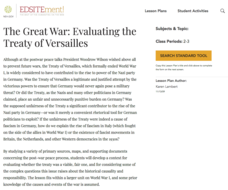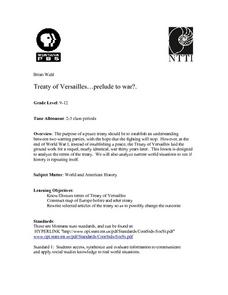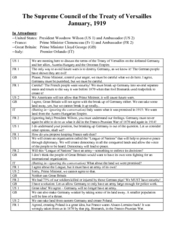Curated OER
End of WWI: The Treaty of Versailles
After learning about the causes and closure of WWI, hand out this resource on that outlines the differences between Wilson's 14 Point Plan and the Treaty of Versailles. The class reads the information provided then analyzes two political...
Alabama Department of Archives and History
Alabama and the Treaty of Versailles
As part of a study of the treaty that ended World War I and the seeds of resentment it planted, class groups compare President Wilson's Fourteen Points and the articles of the Treaty of Versailles.
Curated OER
Treaty of Versailles
Students describe the purposes of the Treaty of Versailles. In groups, they analyze the causes and effects of the treaty and discuss why the Americans were so against it. They note ideas for and against its ratification and they make...
Curated OER
The Great War: Evaluating the Treaty of Versailles
Young scholars examine and evaluate the Treaty of Versailles. They read and discuss primary source documents, explore various websites, develop a list of postwar goals for France, Germany, and the U.S., and evaluate whether the treaty...
Curated OER
The Treaty of Versailles: June 1919
There were four key players involved with the Treaty of Versailles. Present information and critical thinking questions regarding Woodrow Wilson, David Lloyd-George, Georges Clemenceau, and Vittorio Orlando. Included also are lists of...
Curated OER
First World War Assessment
Here is a really neat assessment, perfect for middle schoolers who have just learned about WWI. The assessment covers the causes and effects of WWI, causes of WWII, the Treaty of Versailles, trench warfare, and key players of the war in...
Curated OER
The Treaty of Versailles and the Effects of WWI
Help your historians comprehend perspectives of the Versailles Treaty by paralleling the event to a peace meeting in the classroom, which 2 participants aren't invited to. Consider making it more relatable: instead of the class going to...
Curated OER
A Flawed Peace
The Paris Peace Conference, the Big Four, and the Treaty of Versailles are all covered in this presentation. Clearly outlined and well-put-together, this is a winning complement to your next lesson on the Flawed Peace.
Curated OER
Paris Peace Conference: Writing a Treaty to End World War I
How did World War I end? Tenth graders role play as experts from countries that were involved in World War I. They write a treaty to end the war and compare it to the Treaty of Versailles.
Curated OER
Treaty of Versailles...prelude to war?.
Students examine the Treaty of Versailles, which laid the ground work for a sequel, nearly identical, war thirty years later.
Curated OER
The Advantages and Disadvantages of the Treaty of Versailles
Young scholars identify the advantages and disadvantages of the Treaty of Versailles. Using the text of the treaty, they discover it created more tension between groups then bringing peace to the region. They discuss how this treaty...
Curated OER
Reenacting the Treaty of Versailles
Students examine how provisions in the Treaty of Versailles contributed to events in WWII. They participate in a debate, researching their position, then presenting their national position orally to the class.
Curated OER
The Treaty of Versailles: An Outside Perspective
In this World War I worksheet, students read an article about the Treaty of Versailles and examine 2 maps. Students then respond to 8 short answer questions based on the information.
Curated OER
The Treaty of Versailles: The League of Nations Student Worksheet
In this world history worksheet, students read a 1-page selection as well as Internet articles about the Treaty of Versailles and the League of Nations and then respond to 8 short answer questions.
Curated OER
The Treaty of Versailles: France, 1919
In this Treaty of Versailles study guide worksheet, students respond to 14 short answer questions. The answers to each of the questions are shown.
Stanford University
League of Nations
An interesting lesson explores the Treaty of Versailles and the creation of the League of Nations to prevent further large scale warfare in World War I. A presentation explains how the United States Congress reacted to the offer to join...
Curated OER
Why do wars occur?
Understanding the causes of war is one way (possibly) to prevent it. World War II is used as a case study to facilitate an understanding of reasons why wars start. Topics covered included Totalitarianism, scarcity of resources, need for...
Curated OER
The Supreme Council of the Treaty of Versailles January, 1919
For this Treaty of Versailles worksheet, 10th graders take the parts Wilson, Clemenceau, George, and Orlando, as well as ambassadors, to read the parts in the play based on Versailles negotiations.
Curated OER
Events and Effects of World War I
Ninth graders explore the main events, key people, outcomes and lasting effects of World War I. They research the lasting effects of World War I on the 20th Century and discuss the Treaty of Versailles and its effects on Germany.
Curated OER
Treaty of Versailles Vs. MAGIC
In this end of World Wars I and II worksheet, young scholars respond to 6 short answer questions pertaining to the Treaty of Versailles and other peace agreements.
Curated OER
World War I For the Soldier
Ninth graders examine the main events of World War I and identify the major points of the Treaty of Versailles. They read and discuss a scenario about boys fighting at school and create a treaty, read the poem "The Sentry" by Wilfred...
Echoes & Reflections
Timeline of the Holocaust
An interactive timeline uses images, videos, primary source documents, and links to informational text to chronicle the history of the Holocaust from 1933-1945.
Curated OER
Treaty of Versailles
Learners watch and listen to a PowerPoint presentation about the Treaty of Versailles, then write an editorial criticizing the Big Three. Students write from the perspective of a German in 1920 who has just learned of the harsh terms of...
Curated OER
World War I
Eleventh graders investigate propaganda used during World War I. In this World War I lesson, 10th graders examine propaganda from the war and analyze war posters. Students then create their own propaganda posters on listed topics.

























